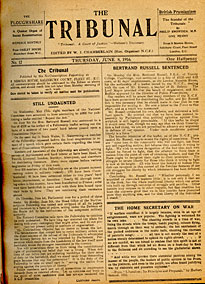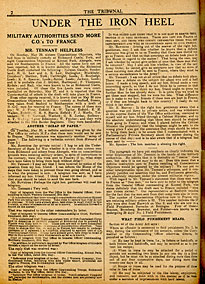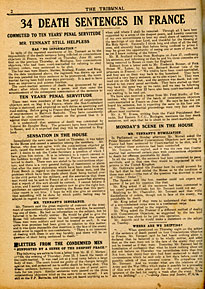
| HOME | TRIBUNAL HOME |
June 1916 was a month of tremendous developments in the treatment and experiences of Conscientious Objectors in the First World War. Many pressures that had been building throughout 1916 were rapidly coming to a head - the fate of the COs sent to France in May was unknown, and the leaders of the No-Conscription Fellowship had heard the first indications that they would be summoned to account for their protests against conscription.
In the wider context of 1916, June saw increasing discontent in the British public. Married men were soon to be conscripted with the extension of the Military Service Act, while the last great surge of volunteers to Kitchener’s army were about to be fed into the slaughter of the western front. Casualty lists were growing longer while newspapers self-censored, denying news to an increasingly disillusioned public. The government, sensing it was losing control of public opinion, increased it’s efforts to stamp down dissent and resistance. In many ways, June 1916 was the last gasp of efforts to totally crush the Conscientious Objector movement. The Tribunal, consistently publishing news that other papers refused to, formed a key part of the anti-war movement in this time of censorship, arrest and punishment.
June 8th, 1916 STILL UNDAUNTED
 “Still Undaunted” adds to May’s ongoing record of NCF members arrested for distributing and writing pamphlets protesting against the Military Service Act. Unlike the previous arrests of David Evans and Morgan Thomas (by now both on their way to civilian prisons), the article discusses the total numbers of men arrested or otherwise punished for producing material the government called “seditious”. Between May and June, additional prosecutions were made - in Penrith, Liverpool, Merthyr, Abercynon and, crucially in London. London saw the most arrests and crackdowns on the distribution of CO literature and of the COs who were to “appear before various magistrates on Friday of this week”, the majority were from the capital. Among the London arrests were eight members of the No-Conscription Fellowship National Committee, who had been sentenced in mid May. The full story of the arrest of the NCF leaders can be seen here, and this article adds further evidence to the growing repression of dissent and resistance that the Government was carrying out.
“Still Undaunted” adds to May’s ongoing record of NCF members arrested for distributing and writing pamphlets protesting against the Military Service Act. Unlike the previous arrests of David Evans and Morgan Thomas (by now both on their way to civilian prisons), the article discusses the total numbers of men arrested or otherwise punished for producing material the government called “seditious”. Between May and June, additional prosecutions were made - in Penrith, Liverpool, Merthyr, Abercynon and, crucially in London. London saw the most arrests and crackdowns on the distribution of CO literature and of the COs who were to “appear before various magistrates on Friday of this week”, the majority were from the capital. Among the London arrests were eight members of the No-Conscription Fellowship National Committee, who had been sentenced in mid May. The full story of the arrest of the NCF leaders can be seen here, and this article adds further evidence to the growing repression of dissent and resistance that the Government was carrying out.
Importantly, the article also makes a short notice that “On Monday June 5th, the Head Office of the No-Conscription Fellowship was raided and stripped of all it’s papers and literature by a force of police, acting under the Defence of the Realm Act”. One of the “papers” confiscated as seditious literature was a bible. The raid on the NCF headquarters was something new for June 1916, but it would soon become a tedious, semi-regular harassment tactic for the Police and Government.
It was by no means the final set of arrests, raids and prosecutions under the Defence of the Realm act that COs and their supporters would face, but June 1916 would see the highest number in a single month at any time during the war.
June 8th, 1916 UNDER THE IRON HEEL
This article picks up the story of the absolutist COs sent to France, which had been revealed in May. The article makes a strong and impassioned case against the government, pointing out the hypocricy, ignorance and helplessness of the politicians nominally “in charge” of dealing with Conscientious Objectors. The main focus of the article is the growing political pressure exerted on the government to challenge the decisions of the military.
It is a direct and challenging article - the use of “Another Scrap of Paper” (referring to the Anglo-Belgian treaty  used as a pretext for entering the war) is heavily drenched in the irony of the situation. Repeating the Under Secretary for War, Harold Tennant - “What difference can it make to my hon. friends if these men are kept in France?” and “It is quite true that we tried to get these men stopped, but we were too late”, the Tribunal makes a powerful and crucial case:
used as a pretext for entering the war) is heavily drenched in the irony of the situation. Repeating the Under Secretary for War, Harold Tennant - “What difference can it make to my hon. friends if these men are kept in France?” and “It is quite true that we tried to get these men stopped, but we were too late”, the Tribunal makes a powerful and crucial case:
Asquith’s Government had no idea what was happening to Conscientious Objectors, and had lost control over the military.
The newspaper stated this point clearly to it’s readers: “It completely justifies our assertion that he [Tennant], and Parliament generally, are absolutely impotent under the current military regime”
The COs in France had been caught up in a wider struggle between Government and Military. Who really ran the country? Whose jurisdiction was law in the British sectors of France and Belgium? The cabinet that had torn itself apart twice, first over the entry into war in 1914 and second over conscription two years later? Or the Military, voraciously consuming an ever larger part of the civil budget and with millions of men and weapons under their direct command?
Tennant had no answers. The military had taken these men, despite clear orders from Parliament, to France. He admitted nothing could stop this from happening - the Military had won this point. Tennant’s cowardly escape: “I really do not think it could matter” ignored the reality of the situation facing the COs in France.
The article goes on to spell it out with extracts from Section 44 of the army act which state the punishments a soldier can face:
“He may be kept in irons.... He may be attached to a fixed object”
In such euphamistic terms, the Army Act described it’s penultimate punishment for disobedience; Field Punishment Number One. As the article went to press, four COs - Staunton, Bromberg, Brewster and Pointer - were standing shackled to fences, posts and carriages, tortured by an indifferent Army.
June 29th, 1916 34 DEATH SENTENCES IN FRANCE
It would take until the end of the month for the experiences of the COs sent to France to be revealed in the Tribunal. The full story of their time in France, from deportation to their final reprieve can be read in our CO Story section.
 In short, while around 50 COs awaited punishment in depots around northern France, they had been faced with the ultimate test of their conviction - obey military orders, or face the death penalty for refusal in combat. They were crammed into tiny, filthy and freezing cells, dragged out to face Field Punishment No1, threatened and intimidated. But, almost at the very last minute, the pressure from supporters at home succeeded - forcing a hasty scramble behind the scenes. The Prime Minister himself was pushed into issuing notices and orders to high positions in the army. We do not know whether or not the Army was truly determined to execute the COs in France, but we do know that it had been considered. Between 30 and 40 (reported here as 34) men were sentenced to death, only to be given commuted sentences of 10 years penal servitude - a vanishingly small measure of mercy.
In short, while around 50 COs awaited punishment in depots around northern France, they had been faced with the ultimate test of their conviction - obey military orders, or face the death penalty for refusal in combat. They were crammed into tiny, filthy and freezing cells, dragged out to face Field Punishment No1, threatened and intimidated. But, almost at the very last minute, the pressure from supporters at home succeeded - forcing a hasty scramble behind the scenes. The Prime Minister himself was pushed into issuing notices and orders to high positions in the army. We do not know whether or not the Army was truly determined to execute the COs in France, but we do know that it had been considered. Between 30 and 40 (reported here as 34) men were sentenced to death, only to be given commuted sentences of 10 years penal servitude - a vanishingly small measure of mercy.
The article that broke this news to the readers of the Tribunal is notable for many reasons, but one of the most important is the feeling of shock it conveys. The NCF knew that it was unpopular, that the government was determined to stamp out all resistance through censorship and imprisonment, but to be sentenced to death for being a CO? That was a new and horrifying development.
Even the formatting of the article suggests that this news was a shock to the CO movement - “TEN YEARS PENAL SERVITUDE” interrupts the flow of text, while the title of the article sees the largest headline the Tribunal had yet used. The inside spread of the issue is crammed full of every possible detail the NCF had gathered on the COs facing the death penalty. With remarkable speed this information had been recieved, collated and publicised well ahead of it’s arrival through official channels with Parliament. Again, the Tribunal reports complete ignorance on behalf of the Under Secretary of State for War and confusion over what was going on seems to reign everywhere - except in the offices of the NCF.
Along with quotations from COs in France, most notably Howard Marten’s letter on resistance and determination: “[I] sincerely hope... I may be given the opportunity of one or more of you, but as yet I know nothing of the future”, the article ends with a posing question asked by the Daily News and Leader:
“We wonder what are the relations of the Army and the War Office which make it possible for a proceeding of this sort to take place and for the civil authority to be ignorant of the fact for nearly a week after the event. Where are we drifting?”
The answer would soon be apparent as the war, and the treatment of Conscientious Objectors entered a new phase.
Conclusion
It’s clear from the Tribunal articles above that for both the COs in France and supporters at home, June 1916 was a watershed moment. In many ways it was the month that changed the CO experience most dramatically. By the end of the month, the full truth of what had happened to the men sent to France had emerged, the NCF saw it’s leaders summoned to court and convicted of sedition and the government would be forced into a humiliating reverse on the treatment of Conscientious Objectors.
But the future would not be easy and many difficulties lay ahead in the coming months. COs would soon see their prospects for resistance change dramatically as a new form of punishment was devised and “The Tribunal” would find itself under threat as the full weight of censorship laws were brought to bear.